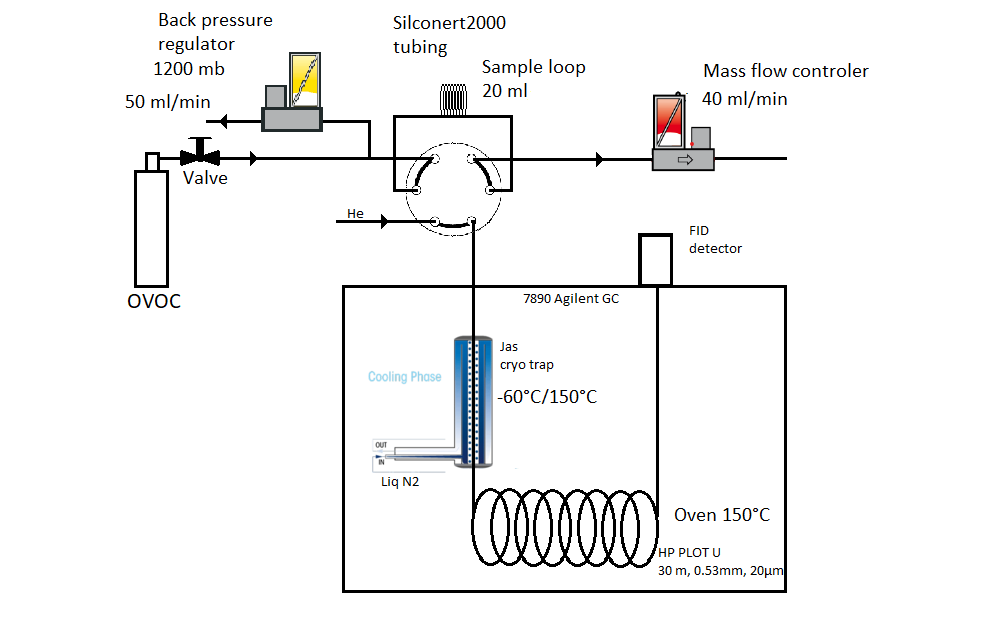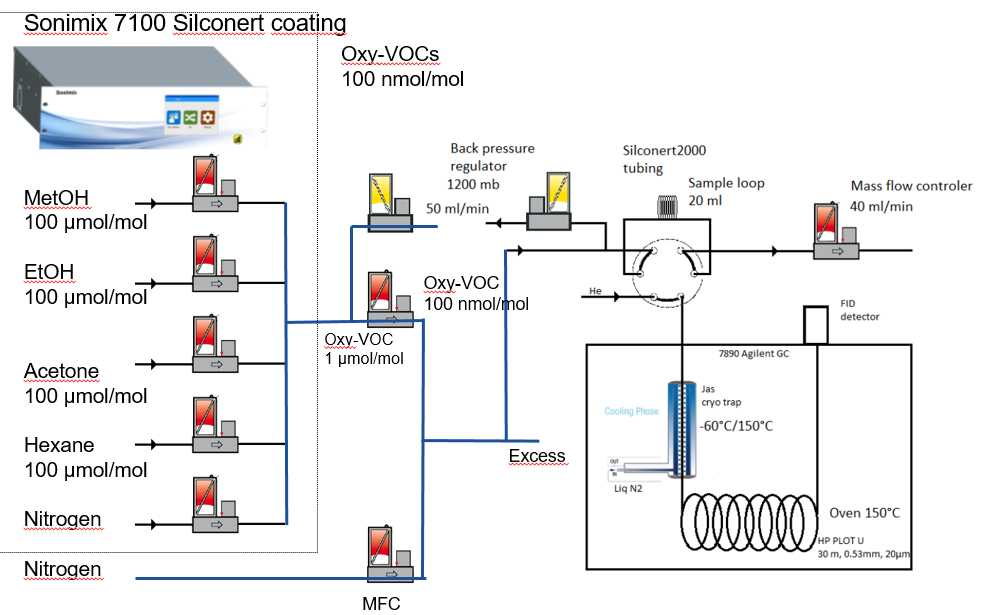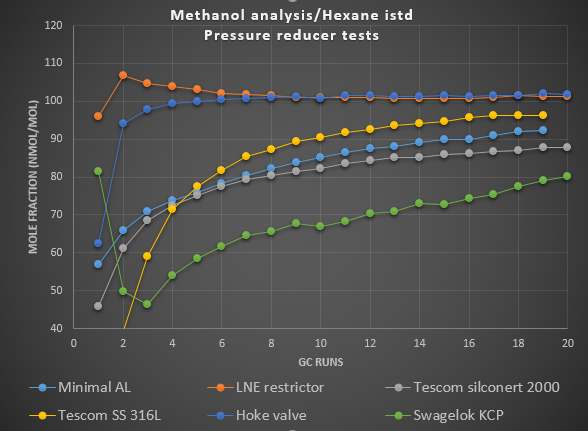# How to produce reference gas mixtures (RGMs) using the gravimetric method
One of the most accurate and often used methods for the preparation of RGMs is the gravimetric method in cylinders. This method is described in the ISO6142-1 standard and consists, by successive weighings, in determining the masses of the compounds introduced into a vacuum cylinder. Traceability to the International System of Units (SI) is guaranteed by the link to the kilogram and by the determination of the purity of the compounds introduced. This method allows to obtain low uncertainties (typically better than 0.1%) on the amount fractions of the gas mixtures prepared since the weighings of the cylinders are carried out with a mass comparator (Figure 1) whose resolution (0.1 mg) is in line with the desired uncertainty. The mass determination of pure liquid compounds is carried out using a microbalance with a resolution of 1 µg.
# Challenging preparation of oxy-VOC gravimetric RGMs
In this project, oxy-VOCs RGMs (ethanol, methanol, acetone and n-hexane as internal standard) at about 100 nmol/mol have been prepared gravimetrically. As the amount fractions of oxy-VOCs compounds in the gas mixtures are very low, it is necessary to carry out several successive gravimetric dilutions to reach amount fractions of the order of 100 nmol/mol in the final gas mixtures.
The production of oxy-VOCs (methanol, ethanol and acetone) RGMs at nmol/mol level is very challenging in terms of accuracy, uncertainty and stability over time. The most critical challenge is to limit as much as possible the adsorption of methanol and ethanol on surfaces in contact with these compounds (e.g. cylinders, valves, regulators, etc.). The choice of the cylinder and its valve is therefore essential.
At LNE, several cylinders are tested in this project with different internal treatments:
- Two 10-liter aluminium cylinders from Air Products (Experis for VOCs) with D200 valve from Rotarex,
- One 3.6-liter stainless steel cylinder from Swagelok coated with SilcoNert® 2000,
- One 3.6-liter stainless steel cylinder from Swagelok coated with Teflon.
The temporal stability of the RGMs produced in these cylinders is under evaluation and will be achieved over a period of two years.
# How to validate the oxy-VOC amount fraction of the RGMs after preparation?
All the oxy-VOC RGMs produced by the gravimetric method must be validated by an analytical comparison with other RGM. This step is important to validate the preparation process and to take into account the analytical results in the uncertainty budget according to the ISO 6142-1 standard.
The method used for the validation of the oxy-VOCs RGMs at 100 nmol/mol is based on the use of a gas chromatograph with a FID detector (GC-FID) equipped with an on-column pre-concentration system. A SilcoNert® 2000 (SilcoTek) sample loop is used to inject 60 mL of the sample at the top of a capillary column that is cooled down to -60 °C by a liquid nitrogen cryo trap system (JAS) to refocus the sample. The system is heated to 150 °C to perform the final injection (Figure 2).

All the parts of the analytical system are coated with SilcoNert® 2000. A LNE’s restrictor is used with the cylinders instead of a pressure reducer to avoid the adsorption phenomena of the oxy-VOCs on the walls.
This system allows increasing the sensitivity of the GC and having very narrow peaks and very good chromatographic separation of the compounds, which is illustrated on the Figure 3.

The GC-FID is calibrated at 100 nmol/mol with RGMs obtained by a two stages dynamic dilution (SONIMIX 7100 dilutor and external mass flow controllers) of the binary oxy-VOCs gas mixtures at 100 µmol/mol (Figure 4).
The values assigned for acetone and n-hexane are based on gravimetric values and those for methanol and ethanol derived from the analysis with two stages dynamic dilution of binary reference gravimetric gas mixtures (RGM).
This analytical method is also used to perform the stability study of oxy-VOC RGMs over time, which is ongoing.

# Special considerations
Oxy-VOCs, in particular methanol and ethanol, adsorb easily on the surfaces in contact with them. To avoid or to minimize this adsorption it is essential to coat all the parts in contact with these compounds and make the surface inert (e.g. Silconert® 2000 treatment). It is more difficult to eliminate the adsorption of these compounds in the pressure reducer of the cylinder due to the high pressure of the gas mixture and the different parts inside the pressure reducer. Figure 5 shows the analytical response of the GC over time, during the analysis of methanol at 100 nmol/mol using different types of pressure reducers.

Twenty GC runs of methanol have been performed after purging the pressure reducers five times in the same conditions. The results show that for methanol, stability and total recovery amount fraction of the RGM is not achieved with pressure reducers after 20 GC runs. The analysis with the in-house made LNE restrictor or Hoke® valve directly connected to the cylinder allowed to achieve 100% of the amount fraction in 8 to 10 runs. These results can be explained by a very small internal volume of the restrictor and the valve and by the small number of internal parts in contact with the gaseous compounds.
As a conclusion, the choice of the system used between the cylinder and the analytical instrument is essential to guarantee accurate measurements for the validation of the gas mixtures and stability studies.
#About the authors

Christophe Sutour, research engineer and technical manager of gas metrology activities at LNE. He has 30 years of experience in the development of reference gas mixtures by dynamic and gravimetric methods. He is well-experienced in the development of analytical methods currently used in European projects (EURAMET) and in international comparisons (CCQM).

Tatiana Macé, head of the department "Gas and Aerosol Metrology" at LNE. She is responsible of the dissemination activities and services for gas and aerosol, such as provision of certified reference materials, calibration and certification of gas mixtures and gas instruments, and technical audits in support to laboratories. She is LNE's representative in the French National Laboratory for Monitoring Air Quality (LCSQA) and she is an expert in several French and International standardization committees.
# Latest post
Go back to the latest blog post.
# Other posts
In this section, you can find the links to previous blog posts.
December 2021 - Terpenes in the atmosphere
October 2021 - Monitoring halogenated VOCs from the space
June 2021 - One year of project MetClimVOC!
March 2021 - How gas surface interactions can affect VOC monitoring?
January 2021 - Halogenated VOCs in the atmosphere: monitoring and traceability
November 2020 - Atmospheric trace gases: VOCs, impact climate change
September 2020 - Welcome to the blog of the project MetClimVOC!